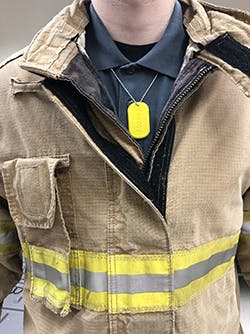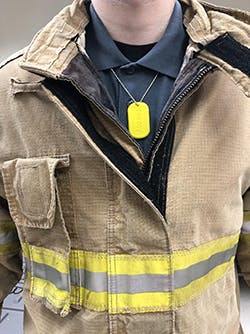Study: On-Duty Firefighters Are Exposed To More Potentially Harmful Chemicals
Firefighters in the Kansas City, Missouri, area, wore personal passive samplers in the shape of a military-style dog tag made of silicone on an elastic necklace. The samplers detect chemicals in the air.
A new Oregon State University study suggests that firefighters are more likely to be exposed to potentially harmful chemicals while on duty compared to off duty. The on-duty firefighters in the Kansas City, Missouri area experienced higher exposures of polycyclic aromatic hydrocarbons, or PAHs, which are a family of chemicals that are known to have the potential to cause cancer. They were also exposed to 18 PAHs that have not been previously reported as firefighting exposures in earlier research. The study, funded by the Federal Emergency Management Agency, is published in the journal Environment International.
The results are important because previous studies have shown that firefighters have an increased risk of developing cancer and other damaging health effects, said study lead Kim Anderson, an environmental chemist and Extension specialist in OSU’s College of Agricultural Sciences. PAHs are a large group of chemical compounds that contain carbon and other elements. They form naturally after almost any type of combustion, both natural and human-created. In addition to burning wood, plants and tobacco, PAHs are also in fossil fuels.
“We don’t have enough data to profile the source of the PAHs, but we know PAHs appear from combustion, and obviously combustion is their work,” Anderson says. “They are also putting on a heavy load of protective gear that has PAHs, and they use cleaning products that have PAHs.”
The firefighters in the study wore personal passive samplers in the shape of a military-style dog tag made of silicone on an elastic necklace. The tags are made of the same material as OSU’s patented silicone wristbands that Anderson’s lab has been using for several years to study chemical exposure in humans and cats. This study demonstrates that the dog tags, which absorb chemicals from the air and skin, appear to be a reliable sampling technology necessary for assessing chemical exposures in firefighters, Anderson says.
“I’m quite confident those exposures existed but if you don’t have something to help you find them you don’t know for sure,” Anderson says. “Certainly, we found that it’s a lot more than what people had thought.”
For more information, visit: www.oregonstate.edu

